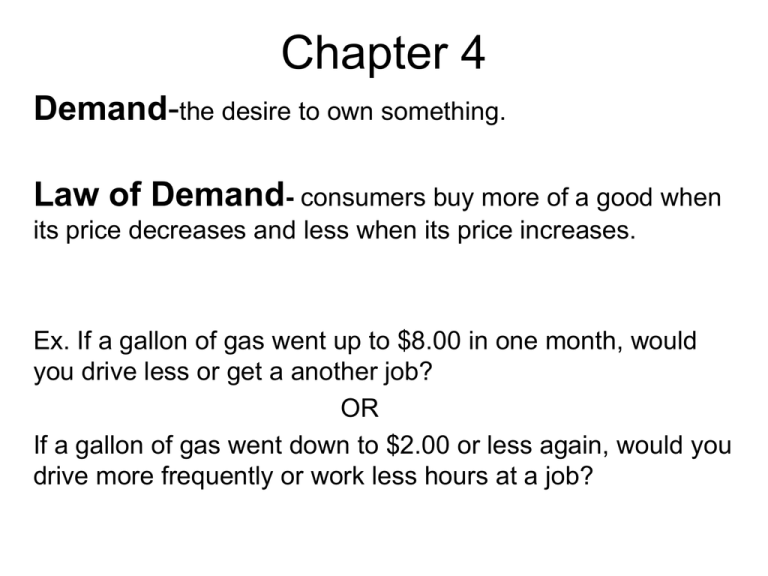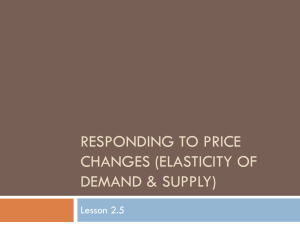Chapter 4 Notes
advertisement

Chapter 4 Demand-the desire to own something. Law of Demand- consumers buy more of a good when its price decreases and less when its price increases. Ex. If a gallon of gas went up to $8.00 in one month, would you drive less or get a another job? OR If a gallon of gas went down to $2.00 or less again, would you drive more frequently or work less hours at a job? Chapter 4 Notes Chapter 4-Demand • Substitution effect- as the price of one item goes up, the consumer buys something else in its place. – Ex. Slice of pizza goes up to $2 a slice from $1. You begin buying tacos instead because they are only $1. • Income effect- change in consumption b/c of a change in real income. – Ex. Price of movie tickets double over the span of a teenager’s high school career. If that teenager is still making the same amount of money since starting high school, then he/she feels poorer and begins cutting back on spending on clothes, food, entertainment, gas, etc. Chapter 4 • The demand curve… • Individual demand and market demand. – Involve the same price per unit, but different amounts purchased…the common factor is the amount decreases for the individual as does the market. • To plot a demand curve, you must have a demand schedule to go by. Chapter 4 Notes Chapter 4 Notes Ch. 4 Section 2- Shifts in Demand Curve • Ceteris paribus- Latin, meaning “all other things held constant.” – A demand schedule only takes the price into effect, not other factors. – Ex. Using gas, if pumping gas caused cancer, then consumers might buy different quantities at the same price. – This would cause the entire graph to shift, resulting in a shift in demand. Chapter 4 Notes Chapter 4 Section 2 • Causes of a shift in demand: – – – – Income Consumer Expectations Population Consumer tastes and Advertisements • Complements- two goods bought and used together; both demand curves affect each other. • Substitutes- goods used in place of each other. • Examples: – Complement-ski boots and skis – Substitute- skis versus snowboards Ch. 4- Section 3 Elasticity of Demand • Elasticity of Demand- a measure of how consumers react to a change in price. • Inelastic-describes demand that is not very sensitive to a change in price. • Elastic-describes demand that is very sensitive to a change in price. • Calculating the elasticity of demand… Equation: % change in quantity demanded % change in price • If demand for a good at a certain price is less than 1,the demand is inelastic. • If demand for a good at a certain price is greater than 1, the demand is elastic. Chapter 4 Notes Elastic Demand Chapter 4 Notes Inelastic Demand Chapter 4 Section 3 • Factors affecting elasticity (What is essential to me?, What goods must I have even if the price rises greatly?): – Availability of substitutes • Life saving medicine (inelastic) • Apple juice, many brands (elastic) – Relative Importance • If a large amount of your income is spent on one good, and that good’s price rises, you must reduce the consumption of that good significantly in order keep your budget balanced. • Clothes, with a modest price increase, drastically affects how many items you buy (elastic) • Another way is if the price of shoelaces doubled…you would not cut back your purchases of shoelaces (inelastic). Chapter 4 Section 3 – Necessities Versus Luxuries • A necessity is a good that is required, no matter the cost. – Milk or baby formula would be a good example. Most families will buy milk or baby formula regardless of a price increase. – Necessities are most of the time inelastic. • A Luxury is good that consumers want to have, but could go without it if the price increases too much. – Steak is a good example. If the price of steak increases by 25%, most people would stop buying it or decrease their consumption relatively close to 25%. – Luxuries are goods that can easily be reduced, making the demand for it elastic. Chapter 4 Section 3 • The elasticity of Demand determines how a change in prices will affect the TOTAL REVENUE of a business. • Total Revenue- the amount of money the company receives by selling its goods. Total Revenue and Elastic Demand: If demand is elastic, and prices are raised, then total revenue will decrease. But if prices are lowered, then total revenue increases. Example: Cost of pizza. If 10 slices are bought at $1, that equals $10 revenue. But if price increases to $2, and only 4 are bought, then revenue decreases to just $8. Chapter 4 Notes Chapter 4 Section 3 • Total Revenue and Inelastic Demand – With Inelastic Demand, Total Revenue increases as price increases. Even though the business may be selling less items, the higher price brings in more money, making up for lower sales of goods. – Also, Inelastic Demand: Total Revenue decreases as the price decreases. Since it is an inelastic demand, not many more goods will be sold. Selling less goods sold at a lower price equals a decrease in total revenue. Chapter 4 Notes











